Sternoclavicular Joint Sprain
Updated:
(Also known as a SC Joint Sprain, Sternoclavicular Joint Injury, Sprained Sternoclavicular Joint, Sprained SC Joint, SC Joint Injury, SC Joint Subluxation, SC Joint Dislocation).
What is a sternoclavicular joint sprain?
A sternoclavicular joint sprain is a relatively rare sporting injury, characterized by tearing of connective tissue and / or ligaments of the joint between the breast bone (sternum) and collar bone (clavicle) at the front / top of the chest (sternoclavicular joint – figure 1).
Each collar bone (clavicle) attaches to the breast bone (sternum) at the top of the chest, just below the base of the neck, and slightly to the side of the midline. Shock absorbing cartilage lines the bone ends, cushioning the impact of one bone on another during activity. Strong ligaments and connective tissue hold these bones together and form what is known as the sternoclavicular joint (figure 1).
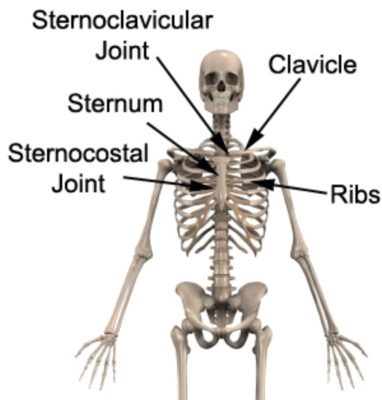
The sternoclavicular joint is the only bony connection between the upper limb and the rest of the skeleton, providing stability to the front of the chest and shoulder and allowing for some shoulder movement. During certain activities, stretching or compressive forces are placed on the sternoclavicular joint. When these forces are excessive and beyond what the joint can withstand, tearing of the ligaments and connective tissue of the joint may occur. This condition is known as a sternoclavicular joint sprain.
A sternoclavicular joint sprain can range from a small sprain resulting in minimal pain and allowing ongoing activity, to a severe sprain resulting in significant pain, deformity and disability.
Causes of a sternoclavicular joint sprain
A sternoclavicular joint sprain typically occurs due to a specific incident, such as a direct blow to the point of the shoulder or top of the chest. This commonly occurs in motor vehicle accidents, in contact sports (due to a collision with another player) or following a fall onto the point of the shoulder or an outstretched hand.
Signs and Symptoms of a sternoclavicular joint sprain
Patients with this condition typically experience a sudden onset of pain at the time of injury, at the top of the chest, just below the neck and slightly to one side of the midline. Pain may increase with activities involving lying on the affected side, moving the arm across the body, overhead arm activities, performing heavy lifting, pushing or pulling movements with the affected arm or, sometimes, during coughing or sneezing. In minor cases of a sternoclavicular joint sprain, patients may be able to continue activity only to experience an increase in pain, swelling and stiffness in the upper chest or shoulder after activity with rest (particularly first thing in the morning).
In more severe cases, pain may prevent the patient from continuing activity and cause them to cradle the arm. Patients may also experience a rapid onset of swelling and may notice a visible deformity or bump at the front of their chest with the tip of their collar bone sticking out. This typically occurs due to tearing of the connective tissue holding the sternoclavicular joint together and the accumulation of swelling and bleeding around the joint or, in more severe cases (such as a motor vehicle accident), due to dislocation of the joint. Patients with this condition may also experience bruising, weakness and pain on firmly touching the affected sternoclavicular joint.
Diagnosis of a sternoclavicular joint sprain
A thorough subjective and objective examination from a physiotherapist is usually sufficient to diagnose a sternoclavicular joint sprain. Investigations such as an X-ray, MRI scan or CT scan are sometimes required to confirm diagnosis, determine the extent of damage or involvement of other structures and rule out other conditions (such as fractures).
Treatment for a sternoclavicular joint sprain

Members Only ContentBecome a PhysioAdvisor Member to gain full access to this exclusive content. For more details see Become a Member. Already a member? Login Now
Prognosis of a sternoclavicular joint sprain

Members Only ContentBecome a PhysioAdvisor Member to gain full access to this exclusive content. For more details see Become a Member. Already a member? Login Now
Physiotherapy for a sternoclavicular joint sprain

Members Only ContentBecome a PhysioAdvisor Member to gain full access to this exclusive content. For more details see Become a Member. Already a member? Login Now
Other intervention for a sternoclavicular joint sprain

Members Only ContentBecome a PhysioAdvisor Member to gain full access to this exclusive content. For more details see Become a Member. Already a member? Login Now
Exercises for a sternoclavicular joint sprain
The following exercises are commonly prescribed to patients with a sternoclavicular joint sprain. You should discuss the suitability of these exercises with your physiotherapist prior to beginning them. Generally, they should be performed 2 – 3 times daily and only provided they do not cause or increase symptoms.
Your physiotherapist can advise when it is appropriate to begin the initial exercises and eventually progress to the intermediate and advanced exercises. As a general rule, addition of exercises or progression to more advanced exercises should take place provided there is no increase in symptoms.
Initial Exercises
Shoulder Blade Squeezes
Begin this exercise by standing or sitting with your back and neck straight. Your chin should be tucked in slightly and your shoulders should be back slightly. Slowly squeeze your shoulder blades together as far as you can go without pain and provided you feel no more than a mild to moderate stretch (figure 2). Repeat 10 times provided there is no increase in symptoms.
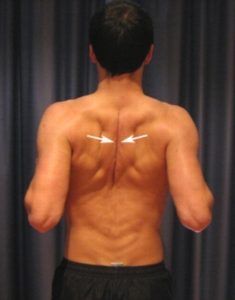
Pendular Exercises
Begin this exercise by leaning forwards with your good forearm supported on a table or bench (figure 3). Keeping your back and neck straight and your shoulder relaxed, gently swing your affected arm forwards and backwards as far as you can go without pain and provided you feel no more than a mild to moderate stretch. Once you have completed this exercise, repeat the exercise swinging your arm side to side as far as you can go without pain and provided you feel no more than a mild to moderate stretch. Repeat 10 times each provided there is no increase in symptoms.
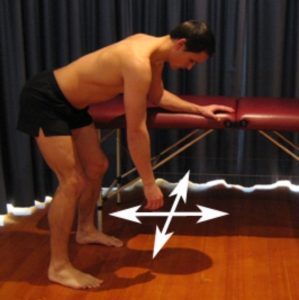
Pendular Circles
Begin this exercise by leaning forwards with your good forearm supported on a table or bench (figure 4). Keeping your back and neck straight and your shoulder relaxed, gently swing your affected arm in circles clockwise as far as you can go without pain and provided you feel no more than a mild to moderate stretch. Once you have completed this exercise, repeat the exercise swinging your arm counter clockwise. Repeat 10 times in each direction provided there is no increase in symptoms.
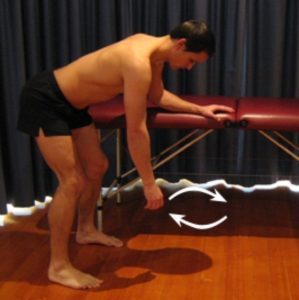
More Initial Exercises

Members Only ContentBecome a PhysioAdvisor Member to gain full access to this exclusive content. For more details see Become a Member. Already a member? Login Now
Intermediate Exercises

Members Only ContentBecome a PhysioAdvisor Member to gain full access to this exclusive content. For more details see Become a Member. Already a member? Login Now
Advanced Exercises

Members Only ContentBecome a PhysioAdvisor Member to gain full access to this exclusive content. For more details see Become a Member. Already a member? Login Now
Rehabilitation Protocol for a sternoclavicular Joint sprain

Members Only ContentBecome a PhysioAdvisor Member to gain full access to this exclusive content. For more details see Become a Member. Already a member? Login Now
 Physiotherapy products for a sternoclavicular joint sprain
Physiotherapy products for a sternoclavicular joint sprain
Some of the most commonly recommended products by physiotherapists to hasten healing and speed recovery in patients with a sternoclavicular joint sprain include:
-
 Wheat Bags
Wheat Bags -
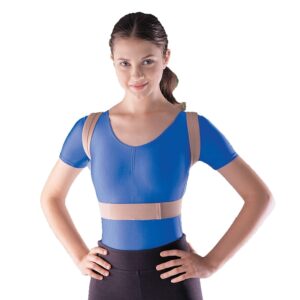 OPPO – Posture Aid / Clavicle Brace (OPP2075)
OPPO – Posture Aid / Clavicle Brace (OPP2075) -
 AllCare Band
AllCare Band -
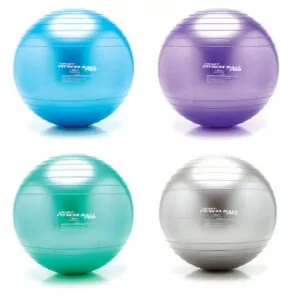 Fitness Ball Pro – Loumet
Fitness Ball Pro – Loumet -
 Premium Strapping Tape 38mm (Victor)
Premium Strapping Tape 38mm (Victor) -
 AllCare Pro-TENS Machine
AllCare Pro-TENS Machine -
 AllCare Tubing
AllCare Tubing -
 Fixomull Stretch 5cm x 10m
Fixomull Stretch 5cm x 10m -
 AllCare Instant Cold Pack (15 x 25cm)
AllCare Instant Cold Pack (15 x 25cm) -
 AllCare Foam Roller Round
AllCare Foam Roller Round -
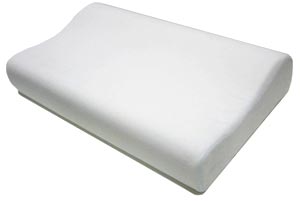 Dentons Impressions Classic Memory Foam Therapeutic Pillow
Dentons Impressions Classic Memory Foam Therapeutic Pillow -
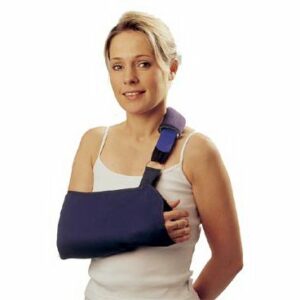 Actimove Arm Sling (Mitella)
Actimove Arm Sling (Mitella)
To purchase physiotherapy products for a sternoclavicular joint sprain click on one of the above links or visit the PhysioAdvisor Shop.
 Find a Physio for a sternoclavicular joint sprain
Find a Physio for a sternoclavicular joint sprain
Find a physiotherapist in your local area to treat a sternoclavicular joint sprain.
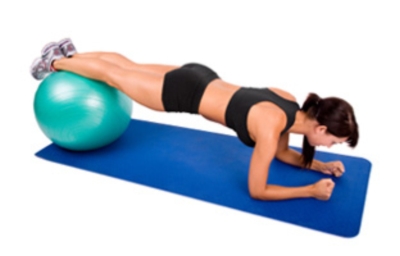 More Exercises
More Exercises
- Shoulder Strengthening Exercises.
- Shoulder Stretches.
- Upper Back Stretches.
- Scapular Stability Exercises.
 More Information
More Information
- Shoulder Taping.
- Postural Taping.
- Ice or Heat.
- R.I.C.E. Regime.
- Returning to Sport.
- Upper Back & Chest Pain Diagnosis Guide.
Become a PhysioAdvisor Member

Link to this Page
If you would like to link to this article on your website, simply copy the code below and add it to your page:
<a href="https://physioadvisor.com.au/injuries/upper-back-chest/sternoclavicular-joint-sprain”>Sternoclavicular Joint Sprain – PhysioAdvisor.com</a><br/>PhysioAdvisor offers detailed physiotherapy information on a Sternoclavicular joint sprain including: causes, signs symptoms, diagnosis, treatment, exercises, rehabilitation protocol, physiotherapy products and more...
Return to the top of Sternoclavicular Joint Sprain.

